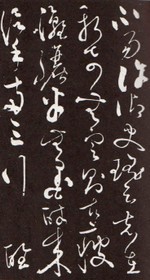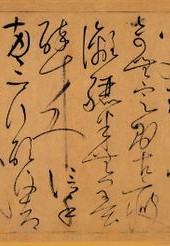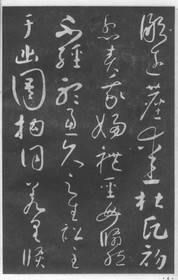[i] In the Shu modelling version of Huai Su's Autobiography(蜀本懷素自叙帖), Huai Su dated the calligraphy as "大曆丙辰(776AD)", while in the Su modelling version (蘇本懷素自叙帖) he dated it as "大曆丁巳(777AD)".
[ii] Strictly speaking, "Sage of the Cursive Script(草聖)" was Zhang Zhi (張芝) not Zhang Xu (張旭). Literature during or before the Tang Dynasty indicated, directly or indirectly, that "Sage of the Cursive Script(草聖)" was exclusively Zhang Zhi:
A. 衞恒 《四體書勢》:弘農張伯英者 ... 韋仲將謂之草聖。Hong Nong's Zhang Boying (Zhang Zhi) ... Wei Zhongjiang declared him to be the "Sage of the Cursive Script ".(interpreted by KS Vincent Poon)Source: 衞恒 《四體書勢》 。上海書畫出版社,《歷代書法論文選》, p.16。上海: 上海書畫出版社, 1979
B. 權德輿《馬秀才草書歌》:伯英草聖稱絕倫。Boying (Zhang Zhi) ,the“Sage of the Cursive Script”, was known to be unrivaled and absolutely fabulous .(interpreted by KS Vincent Poon)Source: 權德輿《馬秀才草書歌》。《全唐詩》 卷三百二十七, p.7。 欽定四庫全書薈要集部全唐詩, 康熙四十六年版。C. 李瀚《蒙求》:伯英草聖。Boying (Zhang Zhi) the“Sage of the Cursive Script”.(interpreted by KS Vincent Poon)Source: 李瀚《蒙求》。《全唐詩》 卷八百八十一, p.5。 欽定四庫全書薈要集部全唐詩, 康熙四十六年版。
Some even distinct " Sage of the Cursive Script(草聖)" from Zhang Xu by naming Zhang Xu as "Zhang the Mad(張顛)":
A. 任華《懷素上人草書歌》:吾嘗好奇,古來草聖無不知。豈不知右軍與獻之,雖有壯麗之骨,恨無狂逸之姿。中間張長史,獨放蕩而不羈,以顛為名傾蕩於當時。張老顛,殊不顛於懷素。懷素顛,乃是顛。I have always been interested in wonders of all kinds, nobody in the past or present does not know the “Sage of the Cursive Script”. Who knew that Youjin (Wang Xizhi) and Xianzhi (Wang Xianzhi), although they both displayed mighty and elegant brushstrokes of compelling manner, regrettably lacked the beauty of “unrestrained mania”. Standing between elegance and mania (in scribing the cursive script) was Chief Clerk Zhang (Zhang Xu) whose styles were exceptionally wanton and uninhibited, and so he was widely known as “the Mad” in his days. Old “Zhang the Mad”, certainly not as “Mad” as Huai Su. Huai Su “the Mad”, truly is “the Mad”.(interpreted by KS Vincent Poon)
Source: 任華《懷素上人草書歌》。《全唐詩》 卷二百六十一, p.4。欽定四庫全書薈要集部全唐詩, 康熙四十六年版。
Today, many contend Du Fu's (杜甫) poem 《飲中八仙歌》declared Zhang Xu was "Sage of the Cursive Script(草聖)". However, they all misinterpreted this key phrase in that poem:B. 蘇渙《贈零陵僧》:張顛沒在二十年,謂言草聖無人傳。Zhang the Mad was gone for twenty years, it is generally said that no one had conveyed the ways of the “Sage of the Cursive Script” anymore.(interpreted by KS Vincent Poon)Source: 蘇渙《贈零陵僧》。《全唐詩》 卷二百五十五, p.8。欽定四庫全書薈要集部全唐詩, 康熙四十六年版。
The key word here is “傳(convey)”. Du Fu merely pointed out that Zhang Xu conveyed the manner of the “Sage of the Cursive Script(草聖)” when Zhang Xu was drunk. He certainly did not proclaim Zhang Xu was the “Sage of the Cursive Script(草聖)”. In fact, there are no known source that directly indicated Zhang Xu was the “Sage of the Cursive-Script(草聖)”.杜甫《飲中八仙歌》:張旭三杯草聖傳。Zhang Xu, after several cups of wine, conveys the manner of the “Sage of the Cursive Script”.(interpreted by KS Vincent Poon)Source: 杜甫《飲中八仙歌》。《全唐詩》 卷二百一十六, p.15。欽定四庫全書薈要集部全唐詩, 康熙四十六年版。
[iii]《書苑菁華》卷十八 , p.15-17。欽定四庫全書子部書苑菁華, 乾隆四十六年版。
[iv] See poems such as《送外甥懷素上人歸鄉侍奉》by Qian Qi (錢起), 《懷素臺歌》by Pei Shuo (裴說), 《草書歌行》by Li Bai (李白), which can all be found in 《全唐詩》(欽定四庫全書薈要集部全唐詩, 康熙四十六年版。)
[v] See footnote (ii).
[vi] In Lu Yu's essay The Biography of Monk Huai Su of the Tang Dynasty (《唐僧懷素傳》), an exchange between Huai Su and Yan Zhenqing discussing the calligraphic forms of "The Leg of a traditional Hairstick(古釵腳)" and "The paths of raindrops falling down the cracks of walls in a house (屋漏痕)" was chronicled:
顏太師真卿以懷素為同學鄔兵曹弟子,問之曰:「夫草書於師授之外,須自得之。張長史覩孤蓬驚沙之外,見公孫大娘劍氣舞,始得低昂廻翔之狀,未知鄔兵曹有之乎?」懷素對曰:「似古釵脚,為草書豎牽之極。」顏公於是佯應而笑,經數月不言其書。懷素又辭之去,顏公曰:「師竪牽學古釵脚,何如屋漏痕? 」懷素抱顏公脚, 唱歎久之,顏公徐問之曰:「師亦有自得之乎?」對曰:「貧僧觀夏雲多奇峯,輒嘗師之。夏雲因風變化,故無常勢,又遇屈折之路,路不自然。」顏公曰:「噫!草聖之淵妙,代不絕人,可謂聞所未聞之旨也。」The exchange could be summarized in English as follows:Yan once asked Huai Su, “Alas, aside learning from a teacher, the art of the cursive script must be achieved by oneself. Zhang Xu once saw a withered grass and blowing sand as well as observed dancing swords to achieve his dynamic cursive script style form of vacillation and swirling. Has your teacher Wu Tong able to achieve this?” Huai Su replied, “(My teacher told me it) Should be like the ‘The Leg of a traditional Hairstick (古釵腳, which appears to be elegant yet strong and powerful)’, such is the ultimate form of a vertical brushstroke in the cursive script.” Yan then let out a laugh and did not discuss Huai Su’s calligraphy for several months. Afterwards, Huai Su approached Yan to say goodbye, this time Yan asked, “You are studying to scribe the form of ‘The Leg of a traditional Hairstick’, how does that compare to the form of ‘The paths of raindrops falling down the cracks of walls in a house (屋漏痕, which refers to a vertical line that is uneven in thickness and curvy)’?” Huai Su then held on to Yan and sighed for a very long time. Yan then slowly asked, “Have you self-reflected and achieve the understanding of the art of the cursive script?” Huai Su responded, “Whenever I see the summer clouds that have many wonderful crests, I learn from them. Summer clouds change with the wind, and hence their manners are always not fixed. I have also looked at crooked roads and paths, but these roads and paths are not natural enough.” Yan replied, “Ah! The deep wonders of the ‘Sage of the Cursive Script’ now has a successor. It can be said that no one has ever heard of what you just contended.”(interpreted by KS Vincent Poon)Source: 《書苑菁華》卷十八 , pp.16-17。欽定四庫全書子部書苑菁華, 乾隆四十六年版。
[vii]啟功, 「論懷素《自敘帖》墨跡本與宋刻本」。見《啟功叢稿》, 北京: 中華書局, 1999, pp.117-119。
[viii]傅申, 「確證《故宮本自敘帖》為北宋映寫本──從《流日半卷本》論《自敘帖》非懷素親筆」。《典藏古美術》,第158期(2005年11月),pp. 86-132。
[ix] See (vii).
[x]

Fig.1 A portion of the Shu version of Huai Su's Autobiography (蜀本 懷素自叙帖)

Fig.2 A portion of the Su version of Huai Su's Autobiography (蘇本 懷素自叙帖)

Fig.3 A portion of the Huai Su's Shengmu tie (聖母帖)
It is evident that the Su Version of the Autobiography (Fig.2) appears to be less consistent with the styles observed in Huai Su's other work Shengmu tie (聖母帖) (Fig.3). The Su version, although offers dramatically different sizes of each character, lacks the dynamic and variations of each brushstroke within one character; it is as if it is written by a solid and hard brush-pen and so each stroke is comparatively boring and unlively. The Shu Version (Fig.1), however, carries more of the same dynamic and variations of each brushstroke as observed in Shengmu tie (聖母帖) . It is hence clear that the person who scribed the Shu version has a higher level of calligraphic skills than the person who scribed the Su version. Note that the dramatic differences in sizes of the characters are certainly important in the aesthetics of the cursive script but the variations within a brushstroke undoubtedly reflect a calligrapher's skills and temperaments.
[xi] “杖錫” refers to the Khakkhara, a "sounding staff" held by a Buddhist monk (see 《佛學詞典》, 香港:菩提學社, 出版年份缺, p.511).
[xii] “上國” means Tang Dynasty’s capital Chang’an, which is currently Xi’an.
[xiii] “錯綜” here means “將資料交叉運用並綜合參考 (take reference to many information)” as in 《漢書》卷一百下敘傳下:「錯綜群言,古今是經,勒成一家,大略孔明。」(班固,《漢書》。 香港:中華書局, 1970, p.4257).